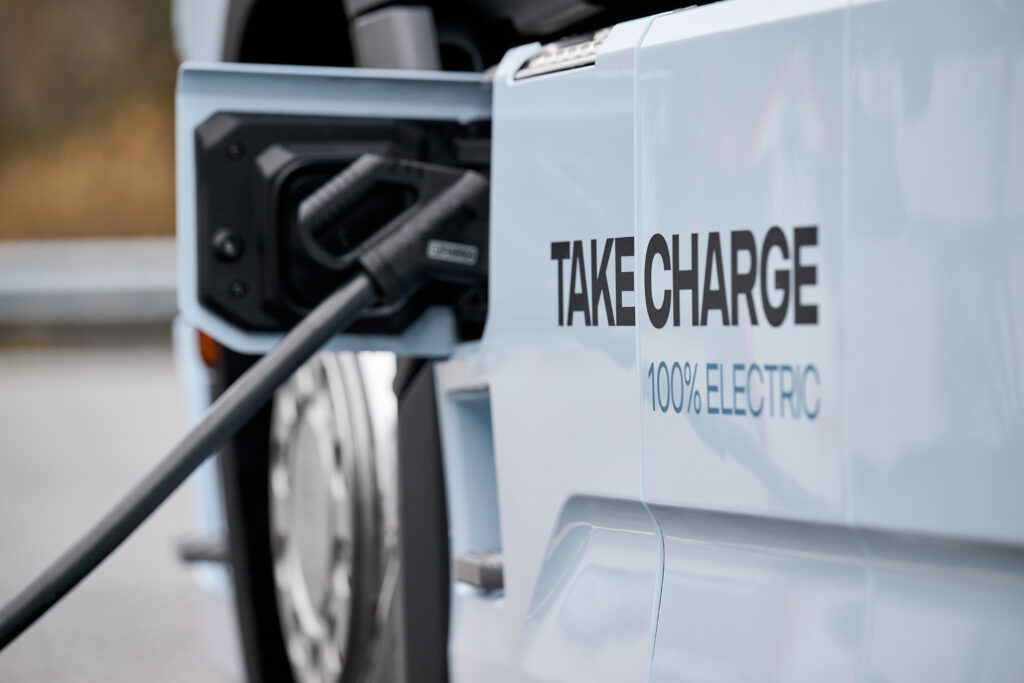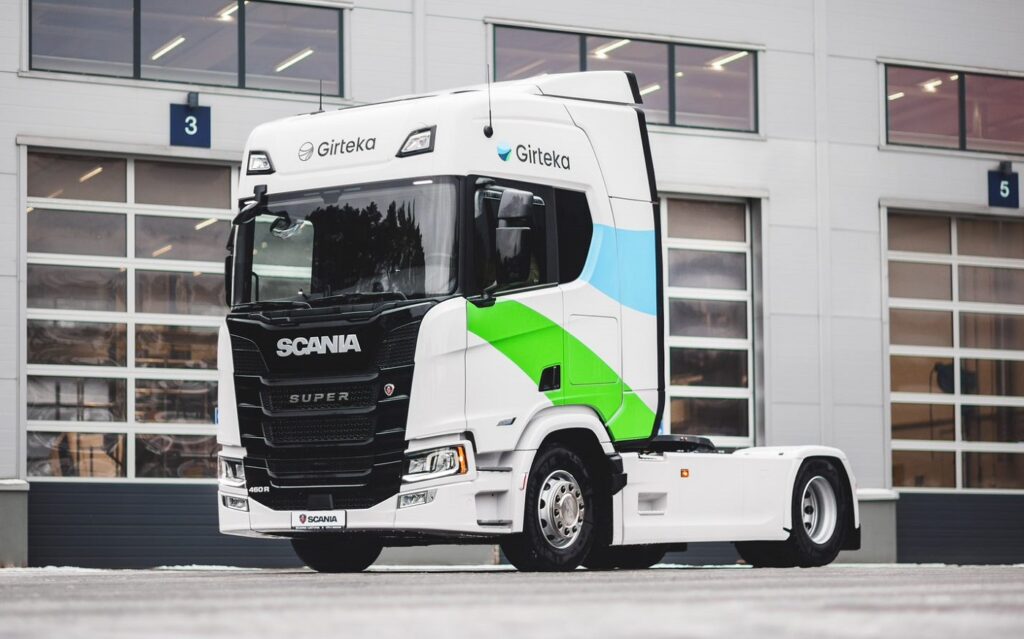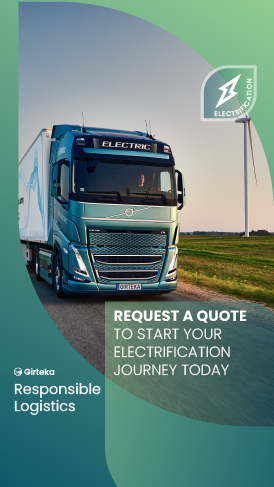While the question has long been “when” and “not if” the road freight transport industry will have to become carbon neutral, the quest for a solution still begins with an “if”, as stakeholders, from manufacturers to carriers, ask themselves whether new technologies can replace the seemingly irreplaceable diesel-powered trucks.
Progress in the trucking industry
Diesel trucks, over the years, have evolved into machines that can reliably take cargo over multiple thousands of kilometres, assuring that supply chains stay intact. Naturally, the diesel engine has its downsides.
Despite reliability being at its peak due to the numerous manufacturing technologies developed by truck makers, the thousands of moving parts in the engine and the gearbox can cause multitudes of issues, especially if they are not the latest solutions or being properly maintained by an authorized service.
Then comes the environmental issue – even if diesel engines manage to adhere to the more and more strict emissions regulations, they still emit harmful particles and greenhouse gases into the environment, contributing to the pollution and smog surrounding cities globally.
CO2 emissions are a significant concern in the transportation sector, and it is important to acknowledge the strides made in recent years to address this issue, particularly in the area of trucking. According to the European Commission (EC) on reducing CO2 emissions, “lorries, buses, and coaches account for more than a quarter of GHG emissions from road transport in the EU and over 6% of total EU GHG emissions.” Despite these figures, the trucking industry has made great strides in improving efficiency and reducing emissions.
As the most advanced and developed segment of transportation, trucks have demonstrated significant progress in adopting innovative solutions and technologies to address CO2 emissions. This commitment to reducing their environmental impact has led to a positive change in the industry and sets a strong example for other sectors in the transportation landscape.
While hydrogen trucks are still in development, electric trucks present a seemingly viable solution to move forward toward a greener future, as they emit nothing while they are on the road in terms of exhaust gasses and/or noise. However much like their diesel counterparts, they are not perfect yet.
Waiting for the perfect battery
One of the biggest drawbacks of an electric truck is its range compared to a diesel truck. In a study by the European Federation for Transport and Environment (T&E), the authors noted that the currently announced ranges of battery electric trucks (BET) “tend to be for urban deliveries and often smaller payloads”.
Furthermore, the authors pointed out that “long haul and larger segment sectors are technically more challenging than the urban delivery truck segment,” especially since long-haul trucks are driven further away from urban centers requiring more payload capacity. Charging infrastructure is also a challenge, as the study pointed out that a “battery electric truck would draw as much power as 2,500 houses,” assuming that it uses a 1 MW connection.
Still, that study was published in 2018. Between now and then, technologies have continued to move forward, and if in 2018, Volvo claimed a range of 300 kilometers for its 16-ton FL Electric, the Swedish Original Equipment Manufacturer (OEM) announced in January 2021 that its HDV electric truck has excelled in “both range and energy efficiency”.
Volvo indicated that the electric FH can have a gross combined weight (GCW) of 44 tons and the total range based on one charge was 345 kilometers. “These test results show that it is possible to drive up to 500 km during a regular work-day, with a short stop for charging, for example during lunch time,” explained Tobias Bergman, the Press Test Director at Volvo Trucks.
Eurostat has stated that according to data as of October 2022, “the average distance travelled per tonne in total road freight transport in the EU was 140.7 kilometers, whereas in national road freight transport, it was 95.1 kilometers, 606 kilometers in international transport, 746.5 kilometers in cross-trade transport and 285.7 kilometers in cabotage transport”. The statistical database of the EC will update the data in September 2023.
Many of these batteries currently powering e-trucks, much like regular cars, are powered by lithium-ion batteries, which have become the “leading candidate for use in electric vehicles,” according to a presentation by Volvo Trucks. “Lithium Sulphur and solid state batteries are also showing great potential for several reasons,” continued the presentation, pointing out that Lithium Sulphur batteries could reach a density of 500 Wh/kg, compared to the density of a lithium-ion battery of 300 Wh/kg.
In general, solid-state batteries “are particularly suitable where high energy density and improved safety are especially important, for example in the automotive sector,” said Dr. Ing. Mareike Partsch, of the Department for Mobile Energy Storage and Electrochemistry at the Fraunhofer Institute for Ceramic Technologies and Systems IKTS, in an interview with Metzler Bank’s Head of Equity Research. Partsch also added that these batteries “are considered the holy grail of battery development”, and as such, “task forces all over the world are working hard to find solutions for the associated problems”.
Measuring the problem
Stereotypically, one of the main barriers for electric trucks is seen as their range and the distance they can cover. However, a study published in January 2023, during which the scholars interviewed truck fleet managers, concluded that electric trucks’ main problems are “the business model and partnerships, product availability, and charging time”. 74 different truck fleet managers/owners based in the United States were interviewed for the article.
Meanwhile, in Europe, the “lack of publicly accessible charging and refueling infrastructure dedicated to trucks is viewed as a primary roadblock to a faster transition and fleets would welcome additional support from other stakeholders to plan the build-out of infrastructure,” per the International Council on Clean Transportation (ICCT) research, which spoke to its European Clean Truck Alliance (ECTA) members, including Girteka.

Lack of charging infrastructure is one of the key issues preventing widespread use of e-trucks in the EU
Hence, can we say that range is the biggest challenge that prohibits electric trucks from entering the market on a massive scale? After all, as the data from Eurostat showed, there is a wide range of missions where trucks are being used throughout the EU. On certain lanes, the comparatively short range of electric trucks could be counteracted by the fact that these trucks would be doing round trips constantly, meaning their route structure would be known beforehand.
Subsequently, companies could collaborate and establish the required infrastructure to ensure that drivers could charge their trucks between stops, as well as during loading and unloading procedures, ensuring that the trucks continue moving, even if they have a lower range than their diesel counterparts.
Collaboration is needed to enable road freight transportation companies to adopt electric trucks. That is not exclusive to carrier/shipper partnerships but should also include governments on an EU-level, as well as a local level. Infrastructure remains a key challenge that all of these stakeholders need to work on to help the logistics industry reduce its emissions.
“Strategic partnerships between shippers, logistics providers, and their transport partners provide a collaborative environment that is more supportive of fleet transformations than one-off, spontaneous spot contracts,” noted the ICCT’s research, adding that “private depot chargers can contribute to a large portion of truck fleet charging needs, and their deployment should therefore be facilitated through public support and increased collaboration between fleet owners, truck manufacturers, utilities, and infrastructure providers”.
At the same time, the wide range of missions would limit operators that have to cover more than 500 kilometers quickly, such as when transporting fresh fish, for example. These are special missions where two-driver trucks are being used, as the very limited shelf life of such products warrants a completely different customer solution that is not similar to that of Fast Moving Consumer Goods (FMCG).
An electric future?
To a certain extent, manufacturers all agree. They have been exploring hydrogen as another solution for the road freight transportation industry. Hydrogen would solve some of the electric trucks’ issues, including range and charging times. Yet hydrogen comes with its own set of problems, including storage, transportation, manufacturing, and refueling infrastructure, which means that the fuel is no silver bullet solution to battery-powered HDV problems. Looking at the future, though, according to another article by the ICCT, the future is indeed electric.
“Battery-electric trucks are expected to dominate new registrations of heavy-duty vehicles in the European market by 2040, while hydrogen fuel-cell trucks will probably play a secondary role,” read an article by the council.
“ETs have the potential to provide significant CO2 reductions at relatively low additional direct manufacturing costs. From a compliance cost perspective, it will be cheaper to electrify most truck segments than to significantly improve diesel technologies to comply with the CO2 reduction targets,” added the ICCT.
The ICCT then pointed out another plus for electric trucks in the battery versus hydrogen debate, arguing that the segment of trucks that drive more than 500 kilometers per day will also benefit from a switch to battery-powered vehicles, as approximate cost savings would be at least 30% higher compared to hydrogen-based trucks. That is “mainly due to the higher operating expenses of fuel-cell trucks, driven by the price of hydrogen fuel and their lower energy efficiency relative to their battery-electric counterparts,” concluded the ICCT.
Still, while electric HDVs come with their own caveats, Girteka has partnered with Scania to achieve an ambitious goal, namely, to introduce up to 600 electric trucks in the next few years. The two companies made the announcement about their collaboration in December 2022, indicating that their partnership will focus on reducing the emissions of the whole sector.

600 electric trucks ready to deliver our clients’ cargo
That is one of the biggest electric truck orders globally. Scania’s truck, which is available as a trailer tractor or a rigid truck, has a maximum range of 350 kilometers. While the range might seem like a limiting factor, but these trucks can perfectly fit into some of the lanes and solutions Girteka has been developing in the past few years, including intermodal rail transport.
Transporting cargo from and/or to a rail station is typically a short drive between the two destinations and since these are known routes, it is again, much easier to develop infrastructure around them. Customers’ interest in intermodal rail transport has only been growing, as it is a relatively easy solution to use to reduce supply chain emissions.
Another solution that is currently being discussed, as mentioned above, are deliveries between two premises on a daily basis, with full infrastructure in both places to reduce time needed for recharging.
But electric trucks are much more versatile than that and could be used on various transportation missions, including transporting parts and/or goods between factories, as well as participating in transportation processes that move freight from ports or airports to companies’ warehouses.
The future of heavy-duty transport is still under question as there is no one best solution and many concerns along the road to carbon neutral road transportation.





